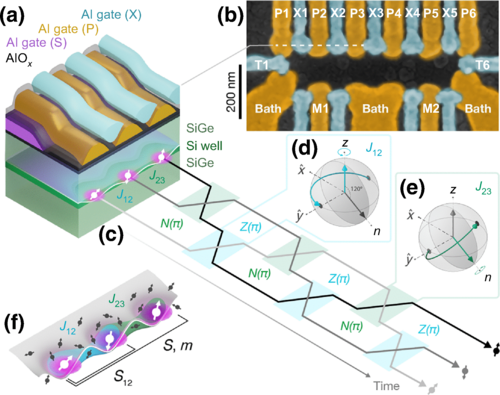Researchers from HRL Laboratories have demonstrated a full permutation dynamical decoupling technique that cyclically exchanges the spins in a triple quantum dot qubit, significantly reducing error rates and extending qubit coherence times. The technique, known as NZ1y, isolates the qubit from error sources, maintaining a quantum state for roughly 18,000 exchange pulses. The team also validated an error model that includes 1/f charge noise and 1/f magnetic noise. The research has implications for the field of quantum computing, particularly in error suppression and qubit coherence, and contributes to the understanding and development of SiSiGe exchange-only triple quantum dot qubits.
What is Full Permutation Dynamical Decoupling in Triple Quantum Dot Spin Qubits?
A team of researchers from HRL Laboratories in Malibu, California, including Bo Sun, Teresa Brecht, Bryan H Fong, Moonmoon Akmal, Jacob Z Blumoff, Tyler A Cain, Faustin W Carter, Dylan H Finestone, Micha N Fireman, Wonill Ha, Anthony T Hatke, Ryan M Hickey, Clayton A C Jackson, Ian Jenkins, Aaron M Jones, Andrew Pan, Daniel R Ward, Aaron J Weinstein, Samuel J Whiteley, Parker Williams, Matthew G Borselli, Matthew T Rakher, and Thaddeus D Ladd, have demonstrated a full permutation dynamical decoupling technique that cyclically exchanges the spins in a triple quantum dot qubit. This technique not only suppresses both low-frequency charge-noise-induced and magnetic-noise-induced errors, but also refocuses leakage errors to the first order. This is particularly interesting for encoded exchange-only qubits.
The researchers used a specific construction, which they call NZ1y, to isolate the qubit from error sources to such a degree that they measured a remarkable exchange pulse error of 28 x 10^-5. This sequence maintains a quantum state for roughly 18,000 exchange pulses, extending the qubit coherence from T22µs to T2720 µs. The team validated an error model that includes 1/f charge noise and 1/f magnetic noise in two ways: by direct exchange-qubit simulation and by integration of the assumed noise spectra with derived filter functions. Both methods reproduced the measured error and leakage with respect to a change of the repetition rate.
How Does Dynamical Decoupling Work?
Dynamical decoupling (DD) sequences suppress dephasing in quantum systems by periodically inverting interactions between the qubit and its environment. When applied to qubits based on electron spins in silicon, DD can extend qubit coherence times to more than 1 s in donor-bound spins and to more than 20 ms in quantum dots. For nuclei in silicon, dynamically decoupled coherence times have been shown to be at least hours long for ensembles and more than 30 s for a single nucleus.
While extended qubit memory is one motivation for DD experiments, the present work focuses on another key function: DD can expose features of noise processes relevant to qubit performance in quantum information processing systems. Specifically, periodic DD sequences act as frequency-domain filters applied to the noise spectrum witnessed by spins. By using this filter-function formalism, one can invert time-domain DD data to extract frequency-domain noise spectra.
What is the Role of Full Permutation Dynamical Decoupling?
The researchers demonstrated a process known as full permutation dynamical decoupling. Unlike electron shuttling techniques, this form of DD exchanges only the electron spin state and is particularly well suited to exchange-only qubits. The team demonstrated that full permutation DD can suppress error rates to 28 x 10^-5 per control pulse, which is a reduction by a factor of almost 50 compared with the error rate of the same qubit obtained from randomized benchmarking.
The decoupling sequence can be used to verify our understanding of qubit noise sources by comparing experimental results with simulation across regimes of magnetic noise and charge noise dominance accessed by varying the repetition rate. The sequence is robust with regard to low-frequency noise as well as miscalibration, allowing the researchers to validate a 1/f spectral character of each of these noise sources to greater precision than is possible with methods such as randomized benchmarking.
What is the SiSiGe Exchange-Only Triple Quantum Dot Qubit?
The researchers applied the full permutation DD sequence to an exchange-only triple quantum dot qubit within an isotopically enhanced silicon quantum well. The quantum dots are formed by the electrostatic potential created by patterned metal gates on a SiGe 28SiSiGe heterostructure, in which the quantum well is 3 nm thick and the 29Si content is reduced to 800 ppm.
This device is different from recent devices fabricated by the single-layer etch-defined gate electrode (SLEDGE) technique. The team’s work with this device and the full permutation DD sequence contributes to the ongoing research and development in the field of quantum computing, particularly in the area of error suppression and qubit coherence.
What are the Implications of this Research?
This research has significant implications for the field of quantum computing. The full permutation dynamical decoupling technique demonstrated by the team can significantly reduce error rates in qubits, leading to more reliable and accurate quantum computations. This technique also extends the coherence time of qubits, which is crucial for the performance of quantum computers.
Furthermore, the technique provides a way to expose and understand noise processes that affect qubit performance. This understanding can guide the design of future quantum devices and systems, helping to mitigate the effects of noise and improve overall performance.
The team’s work with the SiSiGe exchange-only triple quantum dot qubit also contributes to the understanding and development of these types of qubits. The successful application of the full permutation DD sequence to this type of qubit demonstrates its potential for use in quantum computing systems.
Publication details: “Full-Permutation Dynamical Decoupling in Triple-Quantum-Dot Spin Qubits”
Publication Date: 2024-06-11
Authors: Bo Sun, Teresa Brecht, Bryan H. Fong, Moonmoon Akmal, et al.
Source: PRX Quantum 5, 020356
DOI: https://doi.org/10.1103/PRXQuantum.5.020356

